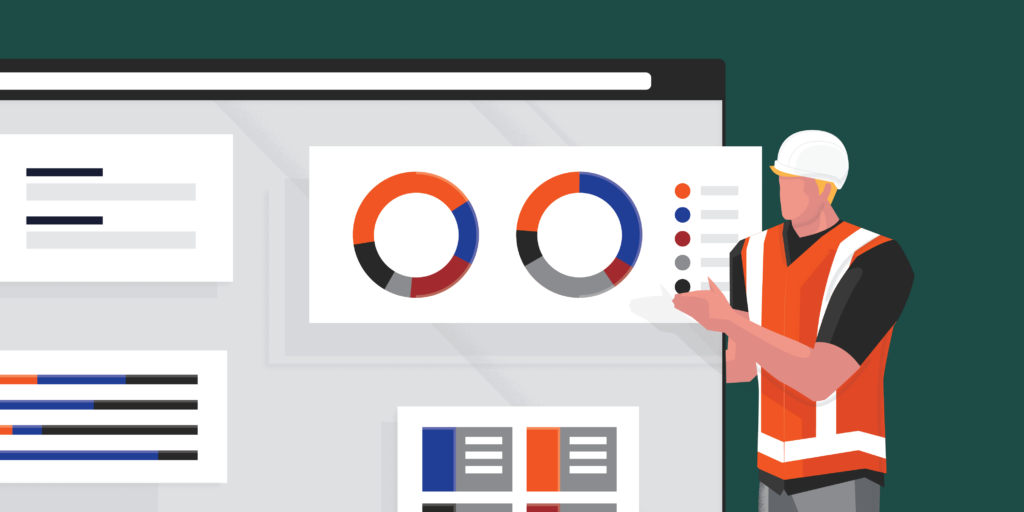— 4 min read
Construction Purchase Orders Explained
Last Updated Jan 24, 2025
Last Updated Jan 24, 2025

A construction purchase order is a key financial element of a project contract. A purchase order (PO) is typically validated by two parties: the buyer and seller. In construction, for example, the owner or general contractor (the buyer) issues a PO to the general contractor or specialty contractor (the seller) to cover the cost of the project.
The document outlines the price and quantity of goods or services necessary to complete the project contract as agreed upon by both parties.
Table of contents
What Information Does a Construction Purchase Order Contain?
In order to illustrate the contents of a construction purchase order and how they are relevant to the completion of a project, let’s use a hypothetical scenario featuring Jane and John. Let’s say Jane is a project manager at a GC hired to build a warehouse while John is a concrete contractor who won the bid to pour the foundation of that warehouse.
Description of Deliverables
Upon receiving the bid for the concrete pour, John and his team visit the site. They identify the tools, equipment, materials, and labor needed to complete the project. Once he relays that information to the GC, Jane’s team will draft a PO for the deliverables outlined by John and his team.
Number of Deliverables
As Jane’s team is drafting the PO, they have to be diligent with listing the quantities for each deliverable provided by John. This is important because a PO explicitly states the GC’s fiscal responsibility for the deliverables needed to complete the work expected of the specialty contractor. This document, therefore, protects both parties by ensuring that:
- The GC receives the amount and quality of work requested
- The SC gets paid for the items needed to complete the work requested
Agreed-Upon Cost
As Jane’s team lays out the itemized list of deliverables requested by John’s team, the two parties will agree on a cost per item and possible discounts for certain quantities of those items.
Terms of Payment
The terms of payment for a construction purchase order are usually based on credit. The GC sends the PO to the SC to request a service on credit. This protects the GC in the event that payment is given before the completion of the project.
The terms of payment can also be set in regards to a net payment term. It defines how many days after an invoice is submitted the buyer has to make the payment. In this scenario, we will say that Jane approves a PO with a net 30 term, which means John will be paid within 30 days of submitting an invoice for the completed work.
Due Dates
Now that the parties have agreed to the terms of payment, Jane and Johns’ teams will decide on due dates for the deliverables requested in the PO. These dates will inform the date of delivery of those deliverables.
Method of Delivery
One of John’s deliverables in the PO is an extra concrete mixer that has to be shipped from out of state. The delivery method for that mixer will typically be defined as one of two FOB (Free On Board) shipping terms: FOB Shipping Point (or FOB Origin) and FOB Destination. If “FOB Origin” is agreed upon, the GC will become responsible for any loss or damages incurred to the mixer as soon as it leaves the warehouse and is in transit to the job site. If “FOB Destination” is agreed upon, the SC will be responsible for any damage incurred to the mixer until it reaches the job site.
Reference Numbers
The reference number is one of the most important pieces of the construction purchase order—it helps track the document. Since a project can have hundreds of PO’s attached to it, they can commonly become lost or jumbled during a project’s lifetime. The only way to prove that a service or material was completed or delivered as requested is to be able to locate the respective PO by its reference number.
Purchase Order, Invoice, Contract: What's the difference?
There is one main difference between a purchase order and an invoice in construction. A PO is submitted by the buyer (Jane the GC) to determine the cost of a contract before the work is completed. In contrast, an invoice is submitted by the seller (John the SC) after the work is completed to receive an agreed-upon payment.
The difference between a purchase order and a contract is that a contract is a legally binding document that covers products, agreed prices, and payment terms, and conditions for the entirety of a construction project. It includes all necessary purchase orders (documents that outline the price and quantity of goods or services necessary to complete the project contract) and invoices.
Key Elements of a Construction PO
A construction purchase order is a key item in a project contract because it’s a legally binding document that protects both the buyer and seller of a product or service. When drafting a PO, it’s important to remember to be explicit and detailed when filling out the following sections:
- Description of deliverables.
- Number (or quantity) of deliverables.
- Agreed-upon cost.
- Terms of payment.
- Due dates.
- Method of delivery.
- Reference Numbers.
Categories:
Tags:
Written by
Harshil Gupta
24 articles
Harshil Gupta is a Product Marketing Manager at Procore. Backed by a stint in engineering and rich experience in growth and product marketing, he's enthusiastic about the role of technology in elevating and enabling other industries. He lives in Toronto.
View profileExplore more helpful resources

Equipped for Success: The Risks and Rewards of Construction Equipment
Even before written language, humans used tools to build. Contractors couldn’t have built the amazing feats seen and used in everyday life without machinery. From handheld tools to multi-storey tower...

The Percentage of Completion Method Explained
Accounting for income and expenses can present a real challenge for contractors, especially on long-term projects. The percentage of completion method is one of the most common methods of accounting...

What Is a General Contractor?
In the construction industry, a general contractor is the person or company responsible for overseeing a construction project. Property owners will typically hire general contractors to ensure a construction job...

MasterFormat: The Definitive Guide to CSI Divisions in Construction
Often referred to as the “Dewey Decimal System” of construction, the Construction Specifications Institute (CSI) MasterFormat is the industry standard in North America for organizing construction specifications. This system enables...